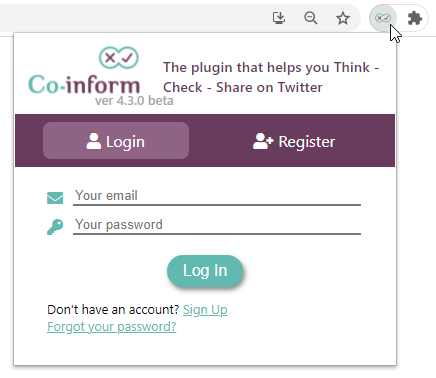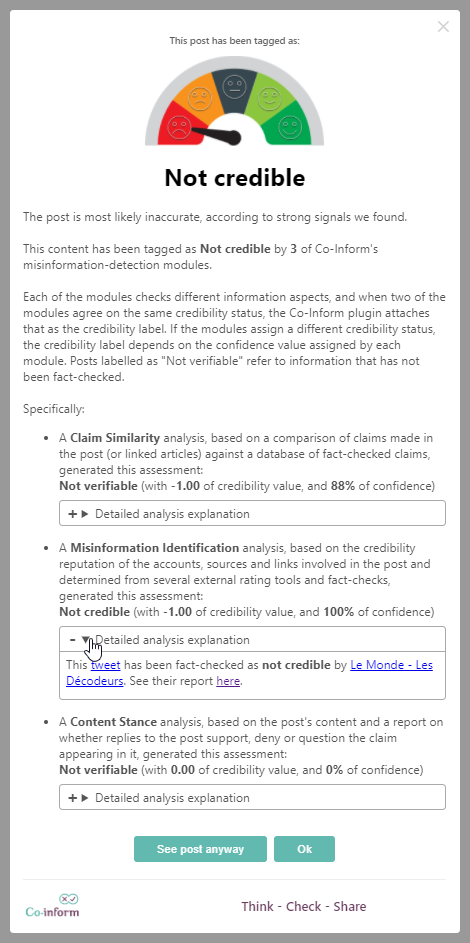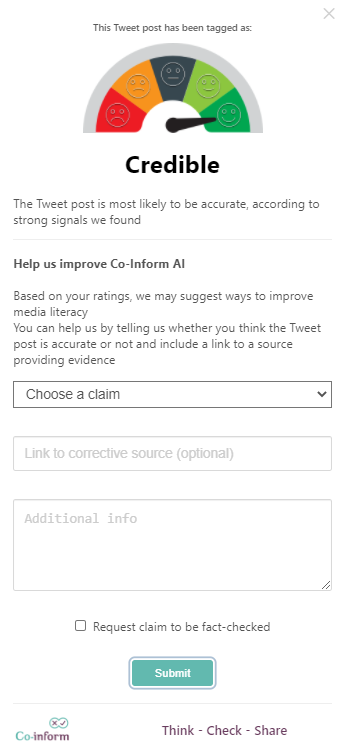Plugin Welcome
Thank you for installing the Co-Inform Browser Plugin!
Misinformation online generates misperceptions. The speed and ease in which false news spread on social media have a massive impact on current affairs and policies. By bringing together a multidisciplinary team of researchers and experts in computer science, behavioural science, and sociology, Co-Inform aims at engaging all stakeholders in fighting misinformation by providing them with the tools to identify ‘fake news’ online, understand how they spread, and provide them with verified information.
To this end, Co-Inform has developed the Browser Plugin, a tool to raise citizens’ awareness of misinforming content, of related fact-checking articles and corrective information, of average citizens’ perceptions towards this content, and of key pro and against comments from fellow citizens. As a proof of concept, Co-Inform has been developed as an extension focused on Twitter content.
This Co-Inform Browser Plugin offers the following functionalities.
Plugin Register and Login
Once the extension is installed, a Co-Inform icon will appear on the navigator bar, through which the user can either register or login, if he/she has registered before.
The User identification is not mandatory for some of the basic nudging functionalities of the extension. But it is needed to interact with the Co-Inform platform by sending user feedbacks and claims.

Plugin Tweets analysis
Once the extension has been installed, when the User accesses any Twitter page, the tweets in such page start to be parsed, sent to the Co-Inform servers to be analyzed, and labelled once the Co-Inform analysis result response is achieved.
There are 5 different levels of credibility labeling, from “credible” to “not credible”, and a special “Not verifiable” case:
-
- Credible, meaning the post is most likely to be accurate, according to strong signals we found.
- Mostly credible, meaning the post is likely to be accurate but may contain some minor inaccuracies, according to the (strong) signals we found.
- Uncertain credibility, meaning the post probably mixes some accurate and inaccurate (or not verifiable) claims.
- Not credible, meaning the post is most likely inaccurate, according to strong signals we found.
- Not verifiable, meaning the post does not contain verifiable claims (it’s all opinions or speculations), or we could not find sufficient signals supporting/refuting the claims in the post.
Once analyzed, the platform assessment of the tweet will be reflected on the Co-inform toolbar.

When the tweet is labeled with a credibility assessment, the user can have a short explanation of the reasons behind the labeling when putting the mouse over the “info” logo next to the label, and a tooltip with a short explanation will appear.

When a tweet is labeled as Not Credible, the extension is configured to raise the nudging strategy called “Blur”, then that particular tweet content is hidden through a blur effect.

When a tweet is hidden, users can click on the “Why can’t I see this?” button to access the tweet’s misinformation score.
The following pop-up appears:

This same analysis explanation pop-up, with extended and detailed analysis information, can also be accessed by clicking on the credibility label for the other assessment cases different than “Not Credible”.
In this explanation popup, for each of the analysis that made up the label, it is possible to find links to articles, to obtain a more detailed explanation of the analysis.
Plugin user feedback
To use this functionality, the user must be identified with his co-inform user account.
Users can agree/disagree with the credibility label assessed by our systems, by using the smiley or sad faces next to the label. Then, the feedback is sent to the Co-Inform platform Data Collector database for further user feedback analysis.

The User can see the other users’ total number of agrees/disagrees of the credibility label on each tweet.
The User can also make a claim regarding the credibility label of a tweet, by clicking on the right-hand side icon of the credibility label toolbar.

A pop-up will appear, with a drop-down menu to choose a claim, a space to specify a link to a corrective source, and space to write any additional information about the claim.

If the User considers it necessary, there is the option to mark the Claim to be reviewed by Fact-Checker agents.
This Claim information is then sent to the Co-Inform platform Data Collector database to be further analysed.
If the Fact-Check option is marked, the Claim is also automatically propagated to the configured Fact-Checking platform, in the actual situation the SOMA’s Truly Media platform, thanks to the integration of the Co-Inform project with SOMA project, a project building collaborative tools for journalists.
Once the Claim is reviewed on such platform (SOMA’s Truly Media), the review result assessment is automatically sent back to the Co-Inform platform Data Collector database. Then the user that originated the fact-checking request is informed about the review result. And there is the idea that further document analysis will also consider such fact-checking review assessment results.
Plugin demo video
Here you can find a demo video of the Co-Inform Browser Plugin citizens oriented tool.
Subscribe to our newsletter
Get our latest project updates, news and events announcements first!

Co-inform project is co-funded by Horizon 2020 – the Framework Programme for Research and Innovation (2014-2020)
H2020-SC6-CO-CREATION-2016-2017 (CO-CREATION FOR GROWTH AND INCLUSION)
Type of action: RIA (Research and Innovation action)
Proposal number: 770302
